Get ready for March Madness with Sports Illustrated's ranking of the best of the best in college basketball.
In eight days, the men's 2021 NCAA tournament will kick off with the First Four, and all will be right again in the college basketball world after a year without March Madness. As special as the sport is in March, though, there been an entire season's worth of games that have already happened.
Heading into March Madness, Sports Illustrated has ranked the top 50 men's players of the regular season, a list that was previously headed by the likes of
Zion Williamson and Obi Toppin. This year's ranking was determined by SI's Jeremy Woo, Kevin Sweeney and Molly Geary, and took into account everything from statistics, year-to-year growth, importance to team and overall performance.First, we'll highlight 10 players that just missed the cut for our top 50. Then, the top 50 will count down from No. 50 all the way to No. 1.
Honorable Mentions: Ochai Agbaji (Kansas), Keve Aluma (Virginia Tech), Scottie Barnes (Florida State), Julian Champagnie (St. John’s), Carlik Jones (Louisville) DeVante’ Jones (Coastal Carolina), John Petty Jr. (Alabama), Terrence Shannon Jr. (Texas Tech), Terry Taylor (Austin Peay), Mark Vital (Baylor)
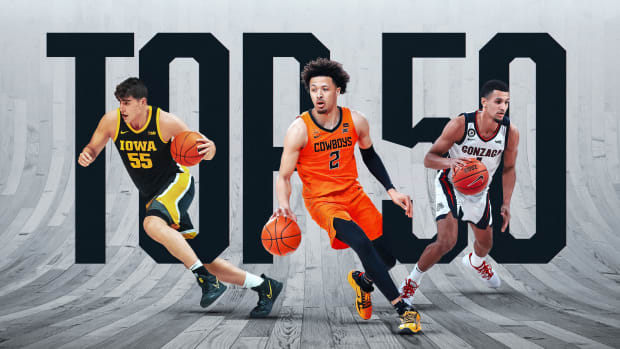
College Basketball’s Top 50 Men's Players of 2020–21:
50. Max Abmas, Oral Roberts, Sophomore
The nation’s leading scorer isn’t Luka Garza or Ayo Dosunmu. It’s Abmas, a sophomore guard at Oral Roberts who has been a one-man wrecking crew for the Golden Eagles in Summit League play. He closed the regular season on a five-game heater that saw him average 34.8 points per game while shooting a blistering 59% from deep, and did all this while being hounded by opposing defenders night in and night out. He may be a bit undersized, but there are very few shooters and scorers as dynamic as Abmas at any level of basketball. And after he scored 23 as Oral Roberts punched its ticket to the Big Dance Tuesday night, America will get to see him on the big stage.
49. D’Mitrik Trice, Wisconsin, Senior
The strength of Wisconsin is in its experienced ensemble cast, but Trice, its point guard, is the straw that stirs the drink. Rarely off the court for the Badgers, the 6-footer has strengthened his play inside the arc this year to complement his always-solid perimeter shooting. His assist-to-turnover ratio is among the best in the Big Ten, but he isn’t afraid to hunt his own shot, particularly in crunch time (see: his incredible effort late in a near-comeback vs. Illinois).
48. Courtney Ramey, Texas, Junior
Texas is a balanced team with six players who average over 8.5 points per game, but Ramey has emerged as the top dog in a resurgent season for Shaka Smart’s club. The junior has torched the nets from deep, shooting a blistering 45% from beyond the arc after knocking down just 31% from deep last season. He also has continued to take on more distribution responsibilities from starting PG Matt Coleman, forming a three-headed backcourt monster with Coleman and shooter Andrew Jones. Ramey is also a terrific perimeter defender who has made life difficult for multiple star Big 12 guards this season.
47. Matt Mitchell, San Diego State, Senior
A four-year starter for the Aztecs, Mitchell has concluded his collegiate career in style as the leading scorer for a top-25 team. The pro departure of Malachi Flynn this past offseason left a significant scoring void for SDSU and Mitchell has filled it admirably, averaging over 15 points per game and shooting 38% from the field for the 20–4 Aztecs. Mitchell is a menace in transition and one of the most versatile defenders in the country thanks to his bulky 6' 6" frame. He’s definitely a name to know on one of the most dangerous mid-majors in the country this season.
46. Marcus Carr, Minnesota, Junior
The Golden Gophers have fallen off a cliff, losing seven straight to drop themselves out of NCAA tournament at-large contention, but don’t let that take away from Carr’s season. While shouldering a heavy load of minutes, the junior has had to carry the bulk of the Minnesota offense, whether that’s through scoring himself or setting up his teammates. While he hasn’t always done the former efficiently, he’s got super-scorer qualities, like when he dropped 41 points on Nebraska or 30 on Iowa. The best version of Carr involves him being aggressive with dribble penetration and getting to the line to put defenses on their heels.
45. Sharife Cooper, Auburn, Freshman
While it’s been something of a lost season for Auburn—and Cooper has missed most of it—he turned in a productive, exciting 12-game stint, averaging 20 points and eight assists and giving the Tigers a shot in the arm. His shooting splits left something to be desired, but Cooper was nearly impossible to keep out of the paint, drawing fouls at a prodigious rate and making an immediate impact. You wonder how things might have been different had he not lost the first half of the season to an eligibility battle.
44. Aamir Simms, Clemson, Senior
The big man has led Clemson to the cusp of an NCAA tournament berth in his senior campaign. Simms may not put up wild scoring numbers, but he influences the game in a multitude of ways for the 16–6 Tigers, leads his team in points, rebounds, assists and blocks. He’s the anchor of a defense that ranks No. 15 nationally in adjusted efficiency per KenPom, and Simms also plays a key role as a distributor when the Tigers play through the elbows or the post.
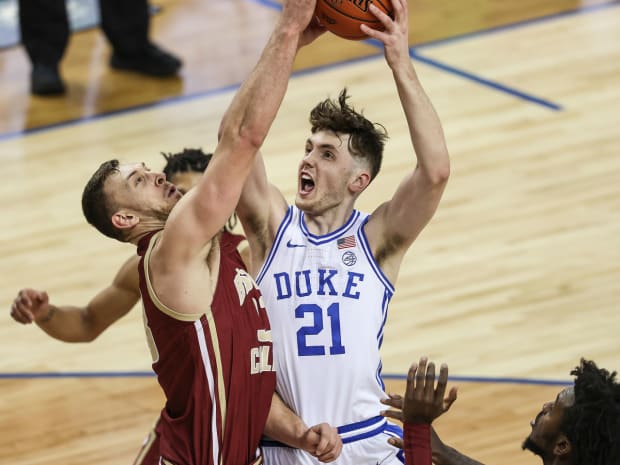
43. Matthew Hurt, Duke, Sophomore
Team-wise, this hasn’t been the season Hurt envisioned when he came back to Durham for a sophomore year, but he’s done his best to keep a young Blue Devils roster afloat. The 6' 9" forward has improved his three-point game to 43.7% this year, but it’s his ability inside the arc (65.2% shooting) that may be the true difference-maker. Hurt still does most of his damage on the offensive end, but there’s no questioning his production there.
42. McKinley Wright IV, Colorado, Senior
Wright became the first men’s player in Pac-12 history to tally at least 1,600 points, 600 rebounds and 600 assists in his career, a tremendous accomplishment for one of the nation’s best stat-sheet stuffers. Wright has led the way for a Colorado team in the midst of a third consecutive 20-win season, and the Buffaloes are a lock to return to the NCAA tournament for the first time since 2016 thanks to his high-level play at the point.
41. Marcus Zegarowski, Creighton, Senior
Creighton’s star point guard hasn’t quite emerged into the All-America candidate some predicted in the preseason, but Zegarowski remains one of the best floor-generals in the country and will lead a top-25 team into the NCAA tournament. Zegarowski is a smooth operator in space and thrives creating shots for a Creighton offense loaded with versatile wings who can score. For Creighton to make a deep run in the Big Dance, it will need elite play from its point guard to lead the way.
40. Ron Harper Jr., Rutgers, Junior
Harper appeared to be on an All-America trajectory early this season before going into a long shooting slump for much of Big Ten play. Still, he’s the best player and leading scorer on a Rutgers team that will likely reach the NCAA tournament for the first time in 30 years. Harper should pass 1,000 career points sometime during the Scarlet Knights’ run in Indianapolis. And if he can turn around the poor shooting that has seen him knock down just 14% from beyond the arc in his last 10 games, Rutgers will be very dangerous this month.
39. Collin Gillespie, Villanova, Senior
Gillespie’s season ended in heartbreak as he tore his MCL on senior night, a brutal blow to a Villanova team that had title aspirations. The senior had put together another fine year as the engine of the Wildcats’ offense, with his deft ability to weave through opposing defenses, draw the attention and then find his teammates when he wasn’t calling his own number. To understand Gillespie’s value, look no further than the 0.83 points per possession ’Nova put up in its first full game without him—a season low for Jay Wright’s group.
38. Neemias Queta, Utah State, Junior
The junior center from Portugal has shined this season after dealing with multiple knee injuries that slowed him down in 2019–20. With the graduation of superstar guard Sam Merrill, head coach Craig Smith redesigned the offense to flow through Queta in the post and the big man has continued to raise his game. Not only is Queta an excellent scorer and rebounder, but he also affects the game heavily with his ability to block shots. He ranks in the top five nationally in blocks per game at 3.0 per contest. Plus, Queta has raised his game down the stretch, averaging 21.8 points, 12.5 rebounds and 2.8 blocks per game in the season’s final six games.
37. Jose Alvarado, Georgia Tech, Senior
The quiet, driving force behind a sneaky good Georgia Tech team, Alvarado has put together a remarkable season, posting elite shooting splits (59.2% from two, 40.6% from three, 88.1% on free throws) and ranking fourth among all Division I players in steals per game. He’s proven himself as one of the toughest players and competitors in college hoops and memorably led an upset of Florida State in January. Alvarado has never enjoyed the same fanfare as many of his peers on this list, but he’s been every bit as good.
36. Bones Hyland, VCU, Sophomore
Beyond having one of the coolest names anywhere, Hyland has had a breakout sophomore campaign to become one of the best guards in the country. He stepped into a lead guard role this season after multiple graduations from last year’s group and has shined, leading the Atlantic 10 in scoring and helping VCU to a bounce-back season. The Rams are in line for an at-large bid to the NCAA tournament and Hyland is the biggest reason why, keying an improved offensive attack while also being a ball hawk on the defensive end. With two more years of eligibility left, Hyland is on the verge of becoming one of college hoops’ biggest stars if he doesn’t depart early for the pro ranks.
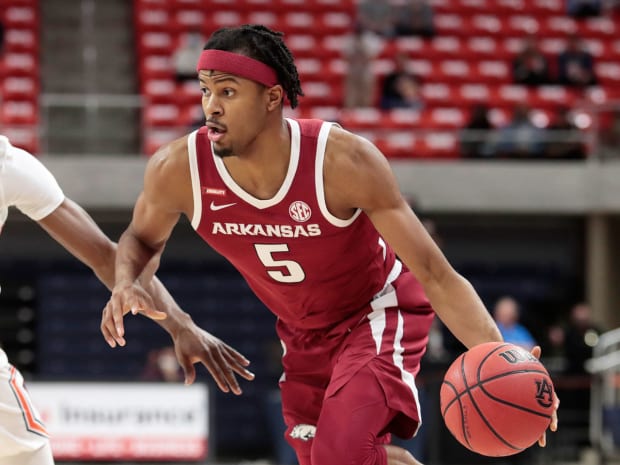
35. Moses Moody, Arkansas, Freshman
Arkansas’s surprising emergence as one of the SEC’s best teams has been driven in part by Moody’s steady sharpshooting. Though not a finished product, he’s proven himself as one of the most college-ready players in this freshman class, shooting 48.1% from two and 38.6% from three and leading an otherwise guard-driven team in scoring and minutes played. Not many 18-year-olds are capable of stepping into a lineup in that fashion, and Moody has established himself as a projected one-and-done first-rounder in the process.
34. Jay Huff, Virginia, Senior
Huff is crucial to this Virginia team, serving as the defensive anchor in the paint for the Cavaliers’ pack line and helping mask some of the issues that keep this Virginia defense from being a vintage one. Plus, how many 7' 1" centers in college do you see shooting 40% from three? Huff is a true stretch five, and shooting 81.1% at the rim to boot. His presence—not to mention his screening ability on the perimeter—unlocks many options for the Virginia offense and its myriad shooters, and it's no surprise that Huff’s on/off splits show a significant advantage to the Hoos when he’s on the floor.
33. Moses Wright, Georgia Tech, Senior
Wright’s meteoric rise from being force-fed minutes and shooting 31% from the field as a freshman to the ACC Player of the Year has been nothing short of remarkable. The Raleigh native has blossomed into one of college basketball’s best power forwards, a menace on the offensive glass who blocks shots and can stretch the floor. Wright also raised his game when it mattered most, averaging 23 points, 10 rebounds and three assists per game in the Yellow Jackets’ six-game winning streak to close the regular season. His outstanding senior campaign is a huge reason why Georgia Tech is likely to reach the NCAA tournament for the first time since 2010.
32. Austin Reaves, Oklahoma, Senior
Oklahoma’s stint near the top of the national rankings may have been short-lived, but Reaves has quietly been among the Big 12’s best players. Serving as the Sooners’ chief scorer, rebounder and playmaker, he’s admirably played a taxing, do-it-all role, lifting his team from off the early radar and into the tournament picture. Apart from streaky three-point shooting, Reaves has put together a memorable senior year, completing his evolution from shooting specialist at Wichita State to full-time lead guard.
31. Joe Wieskamp, Iowa, Junior
The Hawkeyes have a litany of offensive weapons, and Luka Garza of course gets the headlines, but don't overlook Wieskamp’s importance to Iowa’s success. The junior is shooting a deadly 48.9% from deep on 135 attempts, the highest percentage of anyone nationally who has attempted at least 75 threes. He uses his 6' 6" frame well in his ability to shoot over defenders, and he gets plenty of opportunities in a Hawkeyes offense that ranks sixth nationally in assist rate.
30. Trevion Williams, Purdue, Junior
The 6' 10", 265-pound center took another step forward as a junior, maintaining his absurd rebounding rate while shouldering the offensive load for a young Boilermakers team and turning into one of the country’s top big men. Only two players nationally take more of their team’s shots when on the floor than Williams, and he leads all major conference players. While he still remains a liability at the free throw line (51%), Williams is a force inside that few teams can match, whether in the Big Ten or elsewhere.
29. Oscar da Silva, Stanford, Senior
Da Silva has been among the most indispensable players in the Pac-12 and a major matchup problem for defenses, as a quality passer and scorer who can quietly dominate a given game. The Cardinal have lost momentum as a bubble team—dropping three straight games with da Silva out injured—but his productive year merits recognition, and he’ll finish among the conference’s leading scorers (and its most efficient). His versatility and consistency, particularly on a team that’s dealt with a host of injuries and absences, has shone through.
28. Charles Bassey, Western Kentucky, Junior
After a knee injury ended his sophomore year after nine games, Bassey got healthy and returned better than before, leading the Hilltoppers to a strong season on the strength of his rebounding and rim protection. He’s been a force in the paint, averaging 17.6 points and 11.8 rebounds and shooting 63% from the field, and memorably spurring a December upset of Alabama. If WKU can make it into the tournament, Bassey will be a load for any higher seed to contend with.
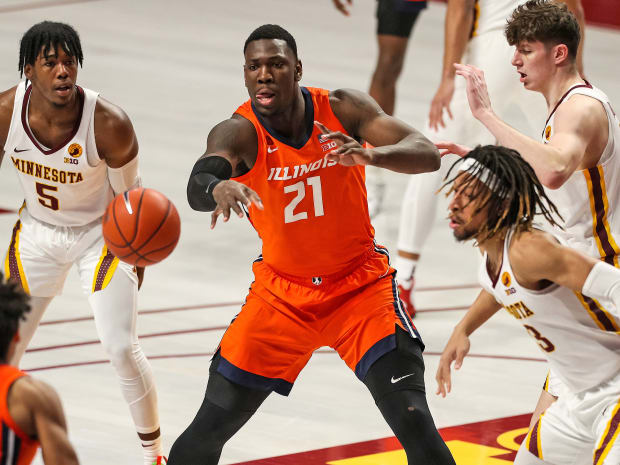
27. Kofi Cockburn, Illinois, Sophomore
One of college basketball’s most intimidating interior forces, Cockburn has raised his game as a sophomore and turned into one of the best big men in the country. While teammate Ayo Dosunmu gets most of the attention for the No. 3 Illini, the Jamaican post player ranks in the top 10 of KenPom’s Player of the Year rankings. A major area Cockburn has improved this year is his efficiency around the rim: He’s shooting 67% from the field this season after just 53% last year. Cockburn has scored in double figures in all but two games this season, and if the Illini get back to the Final Four for the first time since 2005 he’ll be a huge reason why.
26. Miles McBride, West Virginia, Sophomore
West Virginia’s transformation into a high-powered offensive team coincided with McBride’s emergence as a potent scorer, breaking out as a dangerous three-point shooter (41.2%) and capable closer. Also a tough-minded defender and solid playmaker, McBride has been among the best players in a conference stacked with quality guards, coming up especially big in wins over Kansas and Texas Tech. He can be streaky, but his knack for making difficult shots off the bounce makes the Mountaineers a legitimate close-game threat and a team capable of making noise in March.
25. Herbert Jones, Alabama, Senior
The Crimson Tide have been one of the surprises of the season, and the do-it-all senior has been a major part of that. Jones isn't going to blow anybody away with his offensive ability or stats, but his value goes well beyond the box score as the perfect glue guy for Nate Oats's system. He rebounds, blocks shots, gets to the free throw line and has even developed a reliable outside shot as a senior after making just one of his 14 perimeter attempts a season ago. He's also one of the SEC's best defenders.
24. Cameron Krutwig, Loyola Chicago, Senior
Krutwig is college basketball’s Nikola Jokić, a hefty big man who wows much more with finesse and passing ability than he does with athleticism. The Algonquin, Ill., native won MVC Player of the Year honors this season and is one of just four players in conference history with at least 1,500 career points, 800 rebounds and 300 assists. The others? Larry Bird, Oscar Robertson and Hersey Hawkins. Krutwig has been essential in the growth of Loyola Chicago into a mid-major power, starting at center as a freshman on the Rambler team that made the Final Four and now leading the way for a team that might be even better than that one.
23. Cameron Thomas, LSU, Freshman
Say what you want about Thomas’s shot selection, but LSU has needed every bucket, and there have been many. It’s rare to find a true freshman capable of shouldering a scoring load in the way he has, and he’s been one of the best when it comes to drawing fouls—converting free throws at an 87.6% clip. That skill has helped cover for his streaky long-distance shooting. Thomas isn’t a perfect player, but he’s advanced when it comes to the things he does well, and the Tigers might not be a tourney-caliber team without him.
22. Joel Ayayi, Gonzaga, Junior
The fact that Ayayi is generally recognized as his team’s fourth-best player tells you plenty as to why the Zags have been so utterly dominant. He excels at making quick-decisions, moving the ball and generally filling in the gaps, operating in a perfect role that plays to his strengths. Ayayi is arguably the best rebounding guard in the country, a capable shooter and premier off-ball cutter, hardly ever forcing a bad shot and playing with a strong understanding of his capabilities. Gonzaga would still be good without him, but he’s a major reason why that team is great.
21. Isaiah Livers, Michigan, Senior
Livers’s continued improvement throughout his college career has been fun to watch. As a freshman, he was a key rotation player and shooter for a Wolverines team that reached the national championship game. He has incrementally added to his game every year since, improving this season both as a shooter and facilitator to help key the Wolverines to a terrific season. Livers has also been lauded for his leadership with this team, helping mesh together a team that features talented freshmen, transfers and returning talent all in one. Livers will likely surpass 1,000 career points early in the Big Ten tournament.
20. Sandro Mamukelashvili, Seton Hall, Senior
Mamukelashvili is the definition of a point forward, a 6-foot-11 big guy who can handle the ball, pass and shoot. With Seton Hall PG Bryce Aiken on the shelf for much of the year due to multiple injuries, Mamukelashvili has had a larger role in creating offense for the Pirates and has thrived. He opened his season with 22 points and 10 rebounds at Louisville and hasn’t looked back since, scoring 20 or more 11 times, including a career-high 32 against rival St. John’s. Mamukelashvili is the type of player who can single-handedly win you a game in March, and his decision this summer to return to Seton Hall after testing the NBA waters turned out to be season-changing for the Pirates.
19. Quentin Grimes, Houston, Junior
After a disappointing freshman season at Kansas, Grimes has turned his career around at Houston and blossomed into one of college basketball’s most prolific scorers. Grimes’s biggest area of improvement this season has been as a shooter: He is the only high-major player in the country shooting at least 39% from deep on three or more makes per game. Add in backcourt mates Marcus Sasser (14.0 ppg) and DeJon Jarreau (10.5 ppg, 4.1 apg), and the Cougars have a three-headed monster capable of getting buckets against anyone in college basketball.
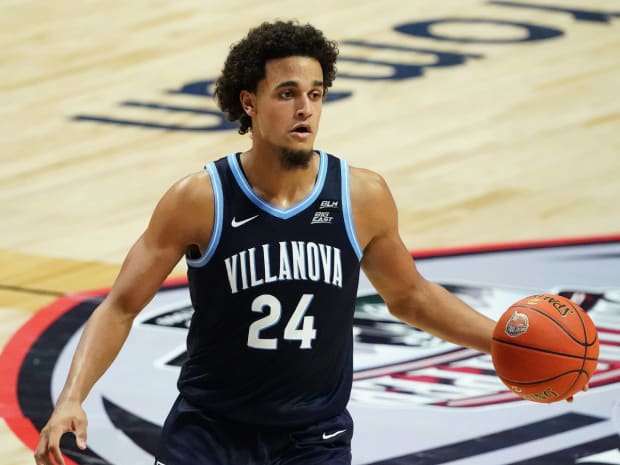
18. Jeremiah Robinson-Earl, Villanova, Sophomore
Robinson-Earl has become an unusual offensive fulcrum for Villanova—something short of a true post player, not quite a perimeter threat, but effective nonetheless. His reliable work on the glass, intelligent passing and defensive positioning have been a stabilizing force the past two seasons, and he emerged as the Wildcats’ leading scorer this season while improving his overall efficiency. His impact doesn’t always manifest in his box score stats, but Robinson-Earl remains among the most versatile bigs in the game and a unique advantage for his team.
17. Sam Hauser, Virginia, Senior
There was good reason the elder Hauser brother looked like an excellent fit for Tony Bennett's offense when he transferred in two years ago. After sitting out a year, the 6’ 8” senior has played a crucial role for the Cavaliers as expected, remaining as efficient a shooter as ever while canning 59.4% of his twos and 44.4% of his threes and rarely being forced into errors. Hauser is a major reason why Virginia’s offense has bounced back so effectively in 2020–21 after its dismal showing last season.
16. E.J. Liddell, Ohio State, Sophomore
If you have to pinpoint one player driving a surprisingly good Ohio State team, it’s Liddell, whose impact is often subtle but always meaningful. At 6’ 7”, 240 pounds, he’s not dominating with pure skill or physicality, but he’s been remarkably effective at making the simple plays, and after a quiet freshman year has turned himself into a dangerous jump shooter. His work on the defensive glass and ability to defend taller players has been a valuable catch-all for a team that lacks size. Liddell’s efficiency and embrace of critical tasks has made all the difference for what’s become a hyper-efficient offensive team. He should be more of a household name before long.
15. Trayce Jackson-Davis, Indiana, Sophomore
The brilliance of Jackson-Davis has been overshadowed by an underwhelming season in Bloomington, but the sophomore big man is the first Hoosier in more than 25 years to average at least 19 points and nine rebounds per game. Jackson-Davis is one of the nation’s most productive post players, an old-school big who hasn’t attempted a three all season but wears you down with his ability to outwork you on the inside. Perhaps the best news for Indiana fans is that his throwback game doesn’t make him as appealing an NBA player, so there’s a good chance he returns to school and wrecks Big Ten frontcourts for at least one more year.
14. Justin Champagnie, Pitt, Sophomore
Pitt’s season nosedived in late January, but Champagnie has been an irrepressibly productive force all season, emerging as an elite rebounder and a player who can do a lot of damage without needing his number called. His motor and instincts in the paint led to big numbers across the board, and his effort on both ends kept the Panthers competitive, even in a string of narrow February losses. He’s been an automatic double double all season (18.4 ppg, 11.1 rpg), and while circumstance has limited his time in the spotlight, he’s quite arguably been the ACC’s best player.
13. James Bouknight, UConn, Sophomore
Although Bouknight missed a large chunk of the season with an elbow injury, he’s more than proven himself as one of the most dangerous scorers around and a player who demands constant attention from the opposition. He’s tough, athletic, and capable of scoring from anywhere on the floor. A healthy Bouknight makes UConn a dangerous team, and he excels at reading defenses, taking the correct shot and finishing with acrobatic flair. He’ll be in the NBA before long, but if he’s all the way back to full strength, the Huskies could make noise in March.
12. Davion Mitchell, Baylor, Junior
It’s hard to say that anyone should have seen Mitchell’s leap from defensive pest to offensive catalyst coming, but he’s blossomed into an excellent two-way player and a tone-setting player for the Bears, pairing with Jared Butler to form arguably the best backcourt in the country. In addition to hounding opposing ballhandlers, Mitchell evolved into a consistent, dangerous shooter off the dribble and a quality distributor, taking on a bigger offensive role comfortably and molding himself into an NBA prospect. He’s a difference-maker who probably deserves more credit in the grand scheme of Baylor’s success.
11. Hunter Dickinson, Michigan, Freshman
It didn't take long for Dickinson to out-play his four-star recruiting ranking in his first year in Ann Arbor, and he currently stands as the highest-ranked freshman on KenPom's Player of the Year ratings. The 7' 1" big man has been a critical piece of the Wolverines' immense success this season, wearing down opposing teams down low while shooting 60.8% from two and proving to be one of the Big Ten's best rebounders. While he does have a tendency to disappear at times offensively, any Michigan path to the national title will likely require him being an interior threat more often than not.
10. Chris Duarte, Oregon, Senior
Duarte is one of the oldest players in the college game, but he plays like it, amassing some ridiculous shooting splits (62.3% from two, 44.0% from three, 80.6% on free throws) and elite block and steal rates and winning a number of games for an Oregon team that entered the year with major backcourt concerns. He’s been truly elite from an efficiency standpoint without ever hijacking the Ducks’ offense, and has done it at both ends of the floor on a regular basis. From an individual perspective, Duarte’s remarkable, under-the-radar season holds up especially well.
9. Franz Wagner, Michigan, Sophomore
Wagner’s sophomore leap has been a driving factor behind Michigan’s success, bolstering the team on both ends of the floor and requiring only a modest diet of shots. The strides he’s made as a playmaker and legitimately versatile defender turned him into the Wolverines’ most essential piece, capable of guarding three positions, knocking down shots and finding open teammates in a pinch. Wagner has shouldered a critical role on a team primarily geared to score by committee, rarely taking a bad shot and displaying a strong understanding of the floor around him. It’s gotten harder and harder to nitpick his game.
8. Jalen Suggs, Gonzaga, Freshman
It’s difficult to separate Gonzaga’s three stars from one another—they’re all impactful in different ways—but it’s Suggs’s relentless guard play that makes the Zags such a dangerous transition team. His athletic gifts and aggressive drives to the paint make him a load for opponents to handle, and a near-impossible cover in open space, where his playmaking skills really shine. On the defensive end, Suggs’s embrace of tough assignments has set the tone for his entire team. He’s been as reliable as any freshman star and a steady engine for the best team in the country.
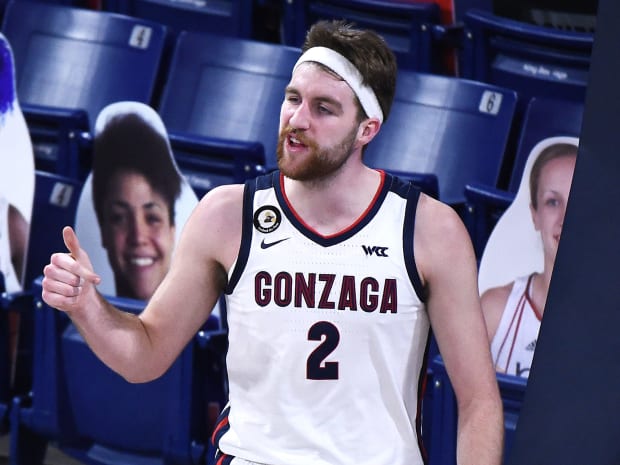
7. Drew Timme, Gonzaga, Sophomore
As the heir apparent in the long line of standout Gonzaga big men, Timme looked primed for a breakout at the beginning of the season, and he's more than realized that potential as a sophomore. Featuring excellent footwork in the paint, a soft touch and the ability to run the floor, he's been frustrating defenses all season while averaging 18.9 points and 7.1 rebounds, all while shooting a ridiculous 67.6% on two-point shots. Plus, have you seen his mustache celebration?
6. Evan Mobley, USC, Freshman
Mobley has been the nation’s premier defensive anchor and one of its most valuable players on whole, taking a USC team that returned just two rotation players and keeping them atop the Pac-12 with his unique skill set. Gifted with immense length and timing as a shot blocker, Mobley wipes away huge chunks of the floor by simply being present. He’s also been a good offensive focal point for the Trojans, with inside-out game and strong passing skills. Mobley’s all-around impact on winning as a true freshman has been wildly impressive.
5. Corey Kispert, Gonzaga, Senior
Kispert is a true modern college basketball success story: someone who stayed all four years and improved each season as he took on more and more responsibility, eventually blossoming into a genuine star as a senior. A sniper from deep who has become equally deadly inside the arc this year, Kispert is one of the most efficient players in the nation. And on a juggernaut Gonzaga team filled with capable weapons, don't be surprised if the senior is the one the Zags would turn to with the game on the line in March—though our No. 8, Suggs, might have something to say about that.
4. Ayo Dosunmu, Illinois, Junior
Dosunmu came back to Champaign to finish what he started at Illinois, and he'll lead the Illini to not only their first NCAA tournament appearance since 2013, but also very likely a No. 1 seed. The 6' 5" guard has turned himself into a National Player of the Year candidate thanks to an improved outside shot and a well-earned reputation as the most clutch player in college basketball. When Illinois needs a bucket, Dosunmu always seems to come through, and not even a late-season broken nose could keep him down long. He's made the most of an improved supporting cast to produce his strongest individual season yet.
3. Cade Cunningham, Oklahoma State, Freshman
After entering the season with considerable hype as the top freshman in the country, Cunningham has worn the mantle well. The proof lies more in Oklahoma State’s surprising team success than in his stats (19.7 ppg, 6.3 rpg, 3.5 apg)—which, apart from a few too many turnovers, are nothing to sneeze at. It’s Cunningham’s unflinching cool, supreme patience and feel for the flow of the game that makes him great. There are no real holes in his skill set, and he’s not someone you want to see at the end of a close game. Cunningham’s ingenuity and consistency set him apart, and the Cowboys wouldn’t be close to the tournament picture, much less a favorable seed, without him.
2. Jared Butler, Baylor, Junior
Baylor’s overwhelming success has been a group effort, but Butler, already the team’s leader, has elevated his play across the board, upping his shooting percentages on twos (54.9%) and threes (44.4%), as well as his assist and steal rates. He’s the Bears’ most creative player, their go-to guy when buckets are scarce, and one of the most reliable players anywhere. Butler’s impact on both ends of the floor is irreplaceable, and Baylor wouldn’t be at the forefront of the title conversation without him. He’s become quite arguably the best true point guard in college hoops.
1. Luka Garza, Iowa, Senior
Garza will finish his career as the most immovable force in college basketball, anchoring Iowa with his post play and a perfected blend of physicality and finesse around the basket. After netting a host of major awards as a junior, Garza returned to school with an improved jumper (43% from three) and turned in a second prolific season, blending productivity and efficiency in a manner seldom seen. The Hawkeyes hitched their wagon to him and never looked back. On most nights, their potent offense covers for what they lack as a group defensively, simply because Garza is so effective. He’s the most dominant player in the sport on a nightly basis.

0 Comments:
Post a Comment